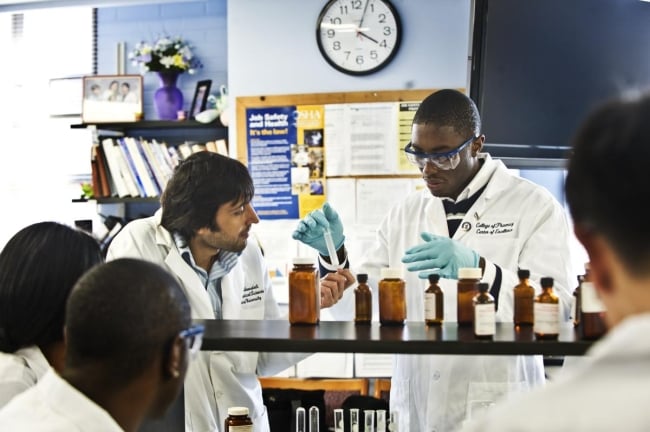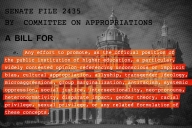You have /5 articles left.
Sign up for a free account or log in.

Howard University is among the HBCUs raising record research funds and hoping to attain R-1 status.
Howard University
Leaders of historically Black colleges and universities have been working to achieve Research-1 status in recent years, the coveted Carnegie Foundation classification reserved for doctoral universities that demonstrate a certain level of research prowess. No HBCU currently holds such a classification, but administrators at some colleges say the designation feels increasingly attainable after years of striving and strategizing and a record year of securing research dollars.
Howard University, for example, raised a record $122 million in grants and contracts this fiscal year, outpacing its goal to reach $100 million by 2024. Howard officials say the institution is the first HBCU to reach that amount after attaining $66 million in 2020 and $91.3 million in research grants and contracts last year, breaking a decade-long streak of bringing in less than $60 million annually.
Meanwhile, North Carolina A&T State University earned $97.3 million in research awards, its second year of record research funding. More than $74 million in federal and state grants was also committed to Morgan State University, mostly for research purposes, in fiscal year 2022.
Willie E. May, vice president of research and economic development at Morgan State, suspects most HBCUs have gotten increases in research funding in the “post–George Floyd era” that led to widespread national discussions about racial inequities in American society, including in higher ed, and the historic role of HBCUs in educating underrepresented students.
This trend could move some institutions closer to the R-1 goalpost. The classification is based on the amount of money an institution spends on research, the number of research staff members employed and the number of doctoral degrees awarded across disciplines to assess the volume, intensity and breadth of the research an institution produces. To qualify for the R-1 or R-2 categories, which indicate “very high” or “high” research activity, respectively, institutions must have awarded at least 20 doctoral degrees and spent at least $5 million on research expenditures in a given year.
“R-1 is the gold standard for quality educational research,” May said. “We can better support the community, the region, our state, our nation and the world by having this merit badge.”
Dr. Wayne A. I. Frederick, president of Howard, said R-1 status comes with a range of benefits in addition to academic prestige. These institutions get invited to apply for more grants and contracts, and they attract leading scholars, which he believes would benefit Howard students. Howard previously held R-1 status in 1987 but fell to R-2 status after an update to the classifications in 2005. University administrators have since set a goal to regain it.
“The types of faculty we would be able to draw would increase the type of instruction and exposure undergraduate students, in particular, would have to high-level research and faculty that are cutting-edge,” he said. “It will also improve our ability to enhance innovative programming, all of which would bode well for the student body that is here.”
Eric Muth, vice chancellor of research and economic development at North Carolina A&T, said R-1 status can help HBCUs produce more top scientists from minority backgrounds.
“When we want to diversify the future of the scientific community, and ensure that it stays diverse, we need to expose our undergrads to science as they’re getting educated,” he said. “And we need to expose them to the best and brightest science going on.”
A ‘Chicken-and-Egg Situation’
A host of barriers has historically stood in the way of HBCUs attaining R-1 status and enjoying its riches.
Lodriguez Murray, senior vice president of public policy and government affairs at the United Negro College Fund, which represents private HBCUs, said implicit racial biases at agencies distributing grants can prevent HBCU scholars from receiving research funding, among other issues. He cited a study by the National Institutes of Health in 2011, which found that Black researchers’ grant applicants were less likely to earn research awards than their white counterparts’.
The biggest obstacle, however, is a lack of financial resources. Murray noted that colleges and universities need money that HBCUs often lack to hire high-level faculty members and build state-of-the-art facilities. Meanwhile, scholars are attracted to colleges already flush with resources and equipped for high-level research.
“It’s a never-ending chicken-and-egg situation that many of the institutions are trying to solve,” he said.
Bruce Jones, vice president for research at Howard, added that research facilities at some HBCUs are old and need repairs or upgrades. And even the wealthiest among them can’t compete financially with the top research institutions, he said. Harvard University has an endowment of more than $50 billion, while Howard’s endowment, the largest among HBCUs, is less than $1 billion. Institutional wealth makes it easier to maintain well-resourced research facilities and pioneer ambitious research projects.
“Where institutions like Harvard are is a function of history and how investments and budgetary allocations have been made over several decades,” he said.
HBCUs have also historically been focused on teaching and entered the research fray later than other institutions, he said.
“Howard University, relative to our HBCU peers, is one of the earliest to embark on research based on facilities and graduate-level degree offerings,” he said. “When you compare that to predominantly white institutions, they have had many decades and many years of being in the research realm.”
Self-Reflection at Carnegie
The lack of HBCUs on the R-1 list has not gone unnoticed by the stewards of the Carnegie classifications, which are now housed at the American Council on Education as of this spring.
Mushtaq Gunja, executive director of the Carnegie Classification systems and ACE senior vice president, said the organization is re-examining the classifications with equity in mind ahead of 2024, when the next round of classifications is scheduled to be released.
The absence of HBCUs in the R-1 category “seems a little crazy, because there’s no question that there’s a whole set of institutions doing incredible research,” Gunja said. “When [the Carnegie Foundation] brought us the classifications, we jointly agreed, why don’t we take a look at what’s going on here? Because this doesn’t feel right. This doesn’t feel good. What is happening?”
He noted that one roadblock for HBCUs is that R-1 status takes into account “comprehensiveness,” the variety of degrees an institution confers, and some HBCUs lack the bandwidth to develop that breadth of degree options. He believes, in some cases, that’s because state systems are investing more in doctoral programs at large public flagships, rather than at HBCUs. HBCUs also may be more likely to channel resources to particular fields based on the needs of their surrounding communities.
“Some institutions are really good at certain things,” he said. “Their institutional mission is really around serving a particular community. They’re embedded in a place that has particular needs and particular interests. There are very few institutions that can be A-plus in 50 different things. In a world of limited resources, choices need to be made about where you want to sort of focus.”
Muth said North Carolina A&T, as a land-grant institution, has historically focused on technical fields and workforce development. University leaders hope to expand program offerings in the health sciences and social sciences to meet employment needs in the state but also to increase its comprehensiveness and advance toward R-1 status.
When the Carnegie classifications were created about 50 years ago, the groupings weren’t necessarily intended to be markers of prestige, merely “descriptive” categories, Gunja said.
He has concerns about R-1 status becoming such a sought-after trophy. That’s part of why the next version of the Carnegie classifications will have a social and economic mobility classification, a separate category for the institutions excelling in educating underserved students. Representatives of the Carnegie classification systems have also met with HBCU leaders pursuing R-1 status to ensure there’s better transparency about how the calculations are done.
“One worry that I have is that the only thing to strive for in the current classification system is excellence in research,” Gunja said. “But there’s a whole set of institutions that don’t have that as their core mission” but are focused on “enrolling first-generation, low-income, students of color … trying to get them to and through college and getting them out with a set of skills that get them employed and on with their lives … We want to create different lanes of excellence, to have institutions be able to see their institutional missions reflected in Carnegie.”
Moving Forward
Despite obstacles to attaining R-1 status, what once felt like an ambitious dream for HBCUs is starting to feel like a not-so-distant reality. The most recent update to the Carnegie classifications last December put 11 HBCUs, out of the 101 in the country, in the R-2 category, which connotes high research activity, a step away from R-1. Leaders of these colleges and universities held a meeting last month to discuss the best strategies for making it into the R-1 category.
“There is some variation on where we all are on that journey,” Jones, of Howard University, said. The group is devising “strategies we can employ moving forward as a collective group to advance all of us toward R-1.”
Some HBCU leaders partly credit an influx of resources after the national racial reckoning that followed social justice protests in 2020.
Murray said HBCUs garnered more philanthropic and research support and attracted students and scholars who might not have otherwise considered these institutions.
“I don’t think that we can discount the ways society has changed because of the deaths of George Floyd and Breonna Taylor,” he said.
HBCU administrators also say R-1 status is in reach because they’ve put in the work. Howard, for example, re-established its Office of Research in 2018 and put attaining R-1 status in its strategic plan. North Carolina A&T plans to use some money gifted by philanthropist MacKenzie Scott to start a new Center for Research in Integrative Health Disparities and Equity Research, in addition to three other “centers of excellence” that already exist in other fields.
Morgan State recently created five interdisciplinary research centers with funding from the state of Maryland, three of which launched this year. Each has funding for new faculty positions. May, of Morgan State, wants the research hubs to help advance the institution to R-1 status but also to serve as a resource to the wider Baltimore community, particularly the new Center for Urban Health Equity and Center for Urban Violence Reduction.
In general, May hopes the pursuit of R-1 won’t negate but will ultimately contribute to the traditional mission of HBCUs—to nurture Black students and provide them with opportunities for upward mobility.
“We plan to do world-class research,” he said. “We also plan to remain this institution that meets students where they are and takes students where they need to be to be successful. HBCUs were created, most of us, to provide education to recently freed slaves. We have evolved over time to take on this research mission, but we cannot forget where our souls are.”
He believes both are possible—and, increasingly, probable. He and other Morgan State employees were skeptical when the university’s president, David K. Wilson, first had the “audacity” to set achieving R-1 status as a goal.
But over time, “We have seen that it is not only doable—it’s something we must do to serve our community in the way we’re committed to serving our community.”









